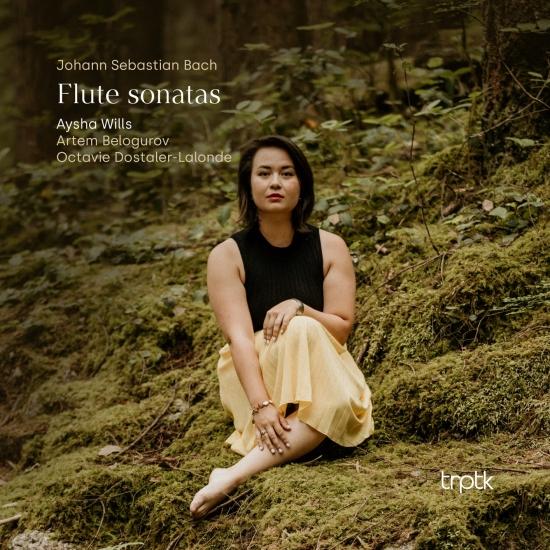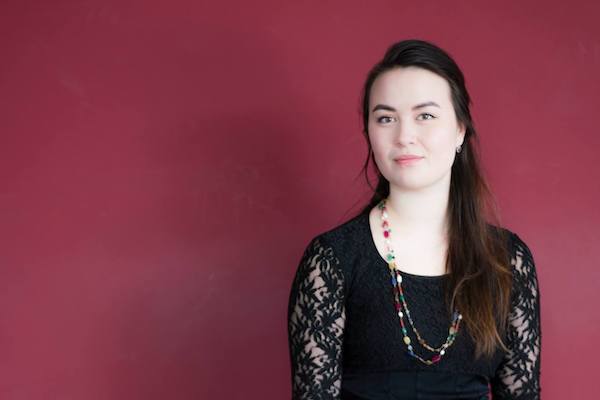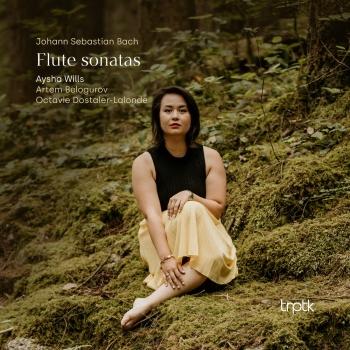
Bach: Flute sonatas Aysha Wills
Album info
Album-Release:
2022
HRA-Release:
30.09.2022
Label: TRPTK
Genre: Classical
Subgenre: Chamber Music
Artist: Aysha Wills
Composer: Johann Sebastian Bach (1685–1750)
Album including Album cover Booklet (PDF)
- Johann Sebastian Bach (1685 - 1750): Sonata in B Minor, BWV 1030:
- 1Bach: Sonata in B Minor, BWV 1030: I. Andante08:01
- 2Bach: Sonata in B Minor, BWV 1030: II. Largo e dolce03:34
- 3Bach: Sonata in B Minor, BWV 1030: III. Presto05:31
- Sonata in E Major, BWV 1035:
- 4Bach: Sonata in E Major, BWV 1035: I. Adagion ma non tanto02:27
- 5Bach: Sonata in E Major, BWV 1035: II. Allegro03:05
- 6Bach: Sonata in E Major, BWV 1035: III. Siciliano03:17
- 7Bach: Sonata in E Major, BWV 1035: IV. Allegro assai03:05
- Sonata in A Major, BWV 1032:
- 8Bach: Sonata in A Major, BWV 1032: I. Vivace05:37
- 9Bach: Sonata in A Major, BWV 1032: II. Largo e dolce02:47
- 10Bach: Sonata in A Major, BWV 1032: III. Allegro04:30
- Sonata in E Minor, BWV 1034:
- 11Bach: Sonata in E Minor, BWV 1034: I. Adagion ma non tanto02:56
- 12Bach: Sonata in E Minor, BWV 1034: II. Allegro02:44
- 13Bach: Sonata in E Minor, BWV 1034: III. Andante03:49
- 14Bach: Sonata in E Minor, BWV 1034: IV. Allegro04:51
Info for Bach: Flute sonatas
On her first solo recording Bach: Flute sonatas she is joined by fellow Postscript members Artem Belogurov (harpsichord and clavichord) and Octavie Dostaler-Lalonde (cello). Recorded in the beautiful setting of the Waalse Kerk in the heart of Amsterdam, this authentic recording is an ode to J.S. Bach's work for flute, both in performance and recording.
“Any time I have been asked what I want to play for my first solo recording, I have felt torn. From an early age and throughout my career, I’ve loved unearthing and programming lesser-known repertoire. What could be more satisfying than ‘rediscovering’ something beautiful, but largely forgotten, and being able to give it a new life? To bring it to a new audience?...
…In the end, it came down to a simple calculation: I could do all that – or I could just record Bach... My love affair with the music of J.S. Bach began early and shows no sign of abating…
…These four sonatas, often referred to as the ‘authentic’ sonatas, as we know with certainty that J.S. Bach penned them, are the cornerstone of my musical career.” (Aysha Wills)
Why Bach?
Any time I have been asked what I want to play for my first solo recording, I have felt torn. From an early age and throughout my career, I’ve loved unearthing and programming lesser-known repertoire. What could be more satisfying than ‘rediscovering’ something beautiful, but largely forgotten, and being able to give it a new life? To bring it to a new audience?
When it came time to make the hard choices for the content of this disc, however, I found myself equivocating: Is the music strong enough? Will it bring joy to both the listener and myself? Can I create a program that makes sense both musically and logically and stands as a unified statement? In other words: Can it be complete?
In the end, it came down to a simple calculation: I could do all that – or I could just record Bach…
My love affair with the music of J.S. Bach began early and shows no sign of abating. Some of my earliest musical memories are of falling asleep to the Goldberg Variations (played by the great Canadian Glenn Gould, in perfect bookends to a remarkable life, and long before I had heard of ‘early music’), a piece which still receives copious airtime in my home.
In the early years of my musical studies, I well remember tackling isolated movements from the flute sonatas and being awestruck at the totality and complexity of the music; the way a simple line in the melody could be so enchanting and memorable, but if you paid really close attention to the bass (something I learned during one of my very first masterclasses with my mentor Marten Root), you would notice that Bach would take that enchanting melody and echo it, or turn it on its head, or invert it, or play with it in any number of astounding ways. If you listened really closely, you could hear that Bach must have loved that melody – and that was the most important thing of all. Like Vivaldi, who was much admired by Bach, the man knew a good hook when he heard one and he was not shy about extracting the maximum mileage from them.
When I moved to the Netherlands in 2011, I was somewhat taken aback to learn that every Easter the entire country goes Bach wild. Every orchestra and choir performs the St. Matthew’s Passion. For the uninitiated, I am not referring to only professional ensembles. No. Everyone. If you play an orchestral instrument or sing-no matter your level- there’s a good chance you’ll have a passion or two each Easter season.
I was 17 when I moved to Amsterdam to continue my early music studies with Marten that year and in 2012 I was thrown in at the deep end. I was recruited to play in my first St. Matthew’s Passion and I have done so almost every year since. It was a revelation. I had known Bach mostly as a composer of instrumental works, but this was a whole new ballgame. I was confronted with the fact that Bach was not merely a monumental composer, but one capable of writing a three hour long vocal work in a language I did not understand, but which set my teenaged brain alight! I was a 17-year-old early music nerd in training, but patience and professionalism were still foreign lands to me. The trial by fire of the Passion gifted me these qualities. I have now played it over 40 times, but I know many musicians who have undoubtedly crossed the 400 mark at this point. The chances are good that it will be the last thing I play before I can play no longer.
In 2017, I presented my master’s thesis on interpreting Bach’s solo flute partita, for which I created a version of the work with a harpsichord accompaniment (no compositional masterpiece, but a valuable learning experience nonetheless) and a research component. It was during this research process that I learned about Pierre Gabriel Buffardin, a French flutist and contemporary of Bach who was the most revered soloist of his time. Bach wrote many of his more complex orchestral parts for him, and we know that the partita (titled originally ‘Solo Pour la Flute Traversiere’) was almost certainly written with him in mind.
When I was preparing for this recording, I hearkened back to my research into Buffardin and realized that his approach to music and flute playing must have been quite cosmopolitan. The one surviving flute built by Buffardin has both German and French qualities, and whilst he was famed for having extremely impressive and quick technique, his flute testifies that he wanted not mere volume and power, but also the ability to play delicately and tenderly. This fusion of Germanic and French tendencies is perfect for these sonatas, which reveal not only how quickly and accurately one can play, but also how beautifully and subtly.
These four sonatas, often referred to as the ‘authentic’ sonatas, as we know with certainty that J.S. Bach penned them, are the cornerstone of my musical career. From my very earliest lessons, during which I would endlessly complain about having to play slow movements on my modern flute, to every graduation recital I played, to my adventures with Postscript and finally to this, my first solo effort, Bach’s music has been one of the few constants in my life. I have found a thousand reasons to avoid recording these sonatas (“I’m not good enough yet!”, “Everyone’s done them”, “Nobody needs to hear another version of these sonatas”, “What would make mine so special?”), but I have finally run out of excuses. This is my white whale. I hope my aim is true.
Why Bach? Well, why not?
Aysha Wills, traverso flute
Artem Belogurov, harpsichord, clavichord
Octavie Dostaler-Lalonde, cello

Aysha Wills
(1994) is a Canadian flautist currently based in Amsterdam. She is specialised in performance on historical instruments. She began her flute studies, aged 5, with Kathleen Schoen in Edmonton and subsequently with Shelley Younge, flautist with the Edmonton Symphony Orchestra.
In 2006, Aysha attended the Boxwood Festival in Lunenburg, Nova Scotia and there met her lifelong mentor and friend, Marten Root. Marten invited her to study with him in Amsterdam as part of the young artists’ program at the Conservatorium van Amsterdam (CvA), and her family moved to Amsterdam in 2007/2008, where Aysha studied baroque flute with Marten and modern flute with Harrie Starreveld. At Boxwood, Aysha also befriended the late David Shorey and acquired her first Flutemakers Guild of London flute from him, sparking a love affair with FMG flutes which persists to this day.
In 2008, Aysha was offered a scholarship to the Glenn Gould School of Music in Toronto, where she spent three years studying with Kathleen Rudolph, before returning to Amsterdam in 2011 to begin a bachelor’s degree at the Conservatorium van Amsterdam, with a double major in historical flutes (with Marten Root) and modern flute (with Harrie Starreveld). She graduated in 2015, the first to complete such an intensive program. Aysha then embarked upon a Masters Degree on Flute in Historical Perspective, with Marten Root and Kersten McCall (Royal Concertgebouw Orchestra), graduating in 2017.
Aysha had the honour of playing as a soloist many times with the Conservatorium van Amsterdam’s Sweelinck Baroque Orchestra, as well working with many modern and early music ensembles in The Netherlands and across Europe, including the Royal Concertgebouw Orchestra, de Nederlandse Bachvereniging (where she held a fellowship between 2014-2017), Concerto Köln, Kölner Akademie, Luthers Bach Ensemble, Wiener Akademie, Won’drous Machine, Das Neue Orchester, l’arte del mondo and Nieuwe Philharmonie Utrecht. She has performed at several festivals including the Oude Muziek Festival Utrecht, Oude Muziek Festival Brugge, Pianoforte Festival Zaandijk (where she was an artist in residence) and Bell’Arte Frankfurt RheinMain. Aysha won the first prize at the Canadian Music Competitions in Montreal in 2009 and is a two-time recipient of the Winspear Foundation Scholarship, which funded her master’s degree, to her eternal gratitude..
Aysha is one of the founding members of the early music ensemble Postscript. Postscript is an award-winning ensemble whose debut CD, Introdvctio (released by Dutch hi-fi label TRPTK), has received copious praise from early music and hi-fi fans across the globe. Their second CD, a recording of 18th century music from Amsterdam, will be released by TRPTK in 2022. Aysha’s debut solo CD, a recording of the authentic flute sonatas by JS Bach, will be released by TRPTK on September 30, 2022.
At age ten, in response to the Asian tsunami disaster, Aysha initiated and helped organize a major concert event which ultimately raised over $750,000. In recognition of her efforts she received several important awards and was commended by the Prime Minister of Canada, the Premier of Alberta and the Canadian Senate. She was given the Award of Distinction by the City of Edmonton, Global TV’s Woman of Vision award and the Alberta Centennial Medal for her efforts. She subsequently organized and played at successful events for the charities Change for Children, Pilgrim’s Hospice and for earthquake relief in Java, Indonesia.
Aysha played and recorded extensively with musicians outside the classical realm as a young artist, in particular with the late and much missed Bill Bourne, winner of multiple Juno awards, and her good friend Madagascar Slim, award winning Malagasy guitarist and splendid human being. She made appearances on CDs with both, and played with them across Canada and on television and radio. She was also mentored by the great Stewart MacDougall (kd lang and the reclines, Great Western Orchestra), who taught her piano and was a friend and neighbour for many years. She had the great fortune to play with many internationally renowned artists such as Chumbawamba, Broken Social Scene, Seth Lakeman, Damien Dempsey, K’naan and Teddy Thompson, to name a few, before choosing to devote her energy solely to her classical studies upon her return to Amsterdam.
In her free time, Aysha likes to spend as much time as she can in the sun, be it while hiking, reading, cycling, having a drink with friends, or simply sitting in her garden. Her biggest passion outside of music is food - she loves both cooking and enjoying a meal in good company. She has a very inquisitive mind, with a particular passion for history. If she hadn’t become a musician, she would have likely pursued paleontology or archaeology as her line of work.













